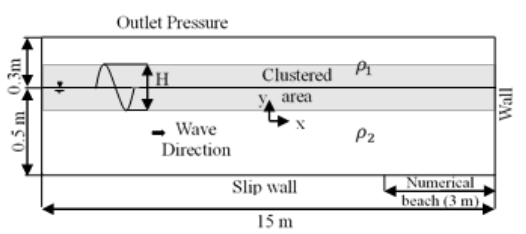Breadcrumb

Design of a Schlieren System for Visualization of Heat and Mass Transfer
In this contribution, a simple yet effective design for Schlieren photography system is described and implemented. The proposed system is used in the visualization of both heat and mass transfer phenomena. Refractive index gradient is created by a lighter to study mass transfer, then the lighter is ignited to create temperature gradient. Results show the ability of the proposed system in capturing the gradients in both mass and temperature gradients. © 2020 IEEE.

Simulation of Water Wave Interaction with Large Submerged Square Obstacles
Modified P3HT:PCBM Active Material with LiF Vertical Cylinders for Organic Solar Cells
In this paper, we introduce active material for an organic solar cell with a modified composition. A combination of P3HT: PCBM with parallel vertical LiF cylinders formulate the active material structure. The collection efficiency in the active material reaches 92.2%. The operating wavelength where the maximum collection efficiency occurs is adjusted and matched with the wavelength where the maximum irradiance of the solar spectrum occurs. The absorption per unit volume of the new structure is 80.4 μm-3 while the blank structure is 75.07 μm-3. The net absorption magnitude for the required
Analytic and numeric analysis for deformation of non-prismatic beams resting on elastic foundations
Background: The buckling load as well as the natural frequency under axial load for non-prismatic beam is a changeling problem. Determination of buckling load, natural frequency, and elastic deflection is very important in civil applications. The current paper used both perturbation method (PM), analytic method, and differential quadrature method (DQM), numerical method, to find buckling load and natural frequency with different end supports. The deflection of the beam resting on an elastic foundation under transverse distributed and axial loads is also obtained. Both PM and DQM are used for
Analytical solution for nonlinear interaction of euler beam resting on a tensionless soil
The nonlinear interaction between an elastic Euler beam and a tensionless soil foundation is studied. Exact analytical solutions of the challenging problem are rather complicated. The basic obstacle is imposing compatibility conditions at lift-off points. These points are determined as a part of the solution although being needed to get the solution itself. In the current work, solutions are derived using the approximate Rayleigh-Ritz method. The principal of vanishing variation of potential energy is adopted. The solution is approximated using a set of suitable trial functions. Lift-off

Experimental investigation of the dynamic characteristics of wrapped and wound fiber and metal/fiber reinforced composite pipes
Turbulent Axisymmetric Non-Isothermal Flow of the Hitec Molten Salt with Temperature Dependent Properties: A Numerical Investigation
Modeling complex flow induced by water waves propagation over submerged square obstacles
Submerged breakwaters are efficient structures used for shore protection. Many design features of these structures are captured upon modeling wave propagation over submerged square obstacles. The presence of separation vortices and large free surface deformations complicates the problem. A multiphase turbulent numerical model is developed using ANSYS commercial package. Careful domain discretization is done employing suitable mesh clustering to capture high gradients. Various numerical model parameters are provided, including grid size and time step. Special attention is directed towards
Analysis of Tapered Timoshenko and Euler-Bernoulli Beams on an Elastic Foundation with Moving Loads
Tandem Organic Solar Cell Optimization Using Response Surface Methodology
Organic solar cells have many advantages such as their ease of manufacturing, flexibility, and low cost compared to perovskite and silicon solar cells. However, increasing their power conversion efficiency (PCE) is still challenging. In this paper, response surface methodology of design of experiments (DOE) is used to optimize the PCE of a tandem organic solar cell. The cell is based on boron sub-phthalocyanine to reduce the series resistance between the layers. The optimization process is performed by formulating an empirical polynomial regression model relating the PCE to the active layers'
Pagination
- Page 1
- Next page ››
